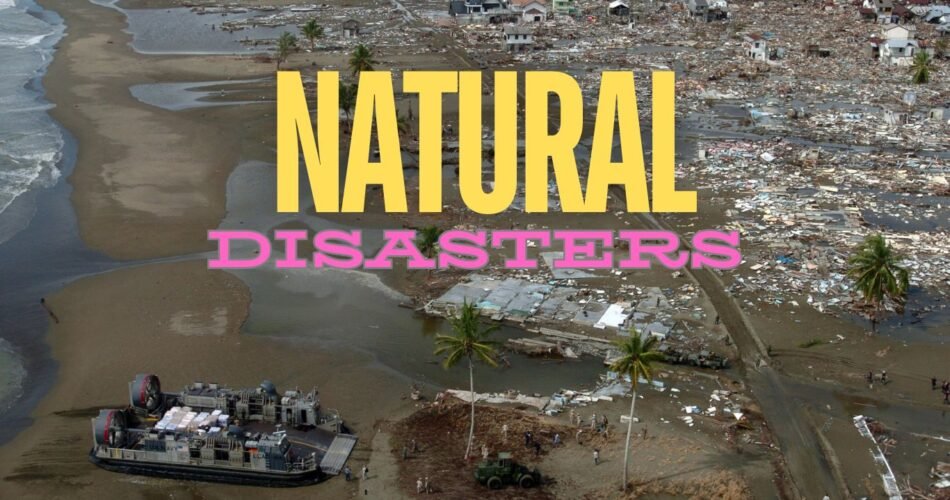This blog contains information about Natural Disasters. In the start it defines and introduces the term Disaster. Then it explain the question what are Natural Disasters in detail. It also mentions 10 Natural Disasters along with their Causes. Then it elaborates the Impacts of Natural Disasters on Human Life and on Environment. In the end, it tells about the strategies to reduce Impacts of Natural Disasters. This blog contains Natural Disasters, Causes, Impacts and strategies to reduce damage.
What is a Disaster?
Disaster is a sudden accident or a natural catastrophe that cause great damage and life loss. It can be called as disruption of the functioning of a community or a society at any scale.
It can be any hazardous events interacting with conditions of exposure, vulnerability and capacity leading to different types of losses or negative impacts. Disaster is any event or accident that cause bad and unfortunate consequences. It can have minor impacts or major impacts but of bad genre. We will learn about Natural Disasters, Causes, Types, Effects and Preventive Measures in detail.
What are Natural Disasters?
Natural Disasters can be defined as the event or accident that occurs natural without any human interference causing damage and life loss.
It is the accident or event that occurs suddenly but because of natural conditions and not the human activities or interference. These disasters are mostly because of natural conditions of but they can be triggered by human activities in long-term effects.
Natural Disaster originates from natural activities going on in the Earth’s crust, atmosphere, Geological cycles, mining, air pressure etc. Most of the natural disasters cannot be predicted before time. Although we can predict some natural disasters with different instruments but the prediction is not 100 percent correct.
Natural disasters cause so much life loss and infrastructure damage every year. These disasters cannot be prevented with any technique because they are from nature and nature cannot be stopped. All we can do is preparing humans, homes, in houses and buildings to reduce their damage. We can also build disaster resilient structures to reduce the damage of natural disasters. We will have a brief discussion on Causes, Impacts and Preventive Measures of Natural Disasters.

10 Natural Disasters and their Causes:
Following are the common Natural Disasters on Earth:
1. Tsunami:
Tsunami is a catastrophic ocean wave. In this condition the waves are inland of the ocean and grow higher and higher as the depth of the ocean decreases. Tsunami can be extremely devastating for people and infrastructure at the coastal areas. These ocean waves can travel across the ocean with the speed of a jet plane.
Causes of Tsunami:
- Earthquake inside the ocean.
- Volcanic Eruption within the ocean.
- Landslides in the ocean.
2. Hurricanes:
A hurricane is a powerful cyclone that rises into the ocean with wind speed 74 miles per hour. It mostly arises in Atlantic Ocean and Northeast Pacific Ocean. This can produce strong winds, heavy rainfall and flooding at the same time. This is a dangerous natural disaster that is basically characterized by high speed winds.
Causes of Hurricanes:
3. Earthquakes:
Earthquakes are sudden violent shaking of the ground causing great destructions. This can be because of different reasons. Earthquakes can be minor, in which humans feels few jerks for few seconds. Or they can be major and destructive enough to turn a well-developed city or piece of land completely destructed within minutes. You can get more information in the blog Earthquakes.
Causes of Earthquakes:
- Release of strain energy from the Earth’s core.
- Volcanic Activity.
- Plate Tectonics of within the earth.
4. Tornado:
Tornado can be defined as violently rotating column of air that extends from a thunderstorm to the ground and looks like a thin funnel. This natural disaster can throw away everything that comes in their way because it is made up of strong wind that can carry objects, humans and other components of infrastructure with it with high speed. This can be extremely destructive.
Causes of Tornado:
- Atmospheric instability during Thunderstorm
- Cold dense air rises above warmer air
- Spinning Air currents inside thunderclouds.
5. Wildfires:
Wildfires are the large and uncontrollable fires that spread across a forest, grassland and rangelands. They can burn thousands of acres of vegetation and tree cover. This fire is extremely intense and can cause life threats to biodiversity and humans. Although it has some positive impacts, but for living creatures it can become fatal.
Causes of Wildfire:
- Lightening.
- Volcanic Activity.
- Spontaneous Combustion.
6. Volcanic Eruption:
Volcanic Eruption is a natural disaster that is characterized by eruption of lava from the depth of the Earth through vents or openings onto the Earth’s surface. This is due to accumulation of heat, hot lava, atmospheric gases and pressure build-up under the Earth. The lava may come out with a blast or silently. It damages the areas from where the lave goes through.
Causes of Volcanic Eruption:
- Landslide within the Earth’s crust.
- Buildup of gases.
- Tectonic Plates movements.
7. Blizzards:
Blizzards are the natural disasters that occurs in very low temperature. It is a storm with large amounts of snow or blowing snow with wind speed of 35 meter per hour and the visibility of less than 0.4 meters. These can last in their extreme level for longer periods. This cause disruption in human activities for days and cause great destructions.
Causes of Blizzards:
- The condition when warm and cold air is together at lower temperatures.
- Differences in pressures of air at locations.
- Extreme temperatures and high pressure air at the same time.
8. Hailstorms:
Hailstorm is the sudden and heavy fall of hail from the atmosphere, that are the solid precipitation different from ice sheets and snow. These have much severe or extreme nature than rain or snow. As the hail is heavier and can damage trees, hurt people and cause destruction of infrastructure even in few minutes. The damage is according to size and weight of hail.
Causes of Hailstorm:
- Strong Thunderstorm clouds.
- Larger water droplets in the atmosphere.
- Lower temperature in specific cloud phase.
9. Mudslides:
Mudslide is a disaster that contains flow of mud and dirt that is liquified with water. This occurs when mud and dirt is mixed with water and makes a slippery viscous material containing loose mud in it. This mostly occurs at steep slopes that travel downwards through gravity. These mudslides can be dangerous enough for humans and animals and there is a risk of falls and slides through them.
Causes of Mudslides:
- Rapid Snow melt.
- Water soaked rocks.
- Heavy rain.
10. Floods:
Floods are one of the most devastating natural disasters on Earth. It is characterized by overflow of water at high speeds from the water resources such as rivers, streams, canals etc. This overflow damages the life and infrastructure coming into its way. This cause great infrastructure, property and life loss every year in the world.
Causes of Floods:
- Extended periods of heavy rainfalls.
- Poor Drainage Systems.
- Deforestation and Dam Failures.
These are the top 10 Natural Disasters that occurs on Earth. This blog contains Natural Disasters, Causes, Impacts and strategies to reduce their damage.
Impacts of Natural Disasters on Human Life:
Following are the impacts of Natural Disasters on Human Life:
. Life loss:
The most negative impact of Natural Disasters is that they threats human lives. Human lives are most precious assets on the planet. Every year natural disasters takes lives of many people in different ways because of damage caused by these disasters.
. Injuries:
Natural disasters such as floods, earthquakes, hurricanes etc. can cause injuries to humans and animals. These injuries may be life-threatening or minor in extent. Many people get injured while saving their lives, protecting their loved ones and helping people in rescue operations after natural disasters.
. Extensive Property Loss:
The locations of natural disasters may face property loss in extensive ways. This can cause economic loss at great levels. It can also cause loss of agricultural land, crops, vegetation and biodiversity present at the location of occurrence of Natural disasters.
. Traumatizing for people:
Many people witness the life-loss of their loved ones and some lose their homes, offices and other important places because of Natural Disasters. These people carry the trauma of their loss throughout their life and become mentally unstable for a long period of time.
. Economic Difficulties:
People who lose their properties, agricultural lands, buildings, houses, assets and many other economically important things in natural disasters face economic difficulties. There is a need of rebuilding everything after a natural disaster and everyone does not have enough resources to do so.
These are the few impacts of Natural Disasters on Human Life.
Impacts of Natural Disasters on Environment:
Following are the Impacts of Natural Disasters on Environment:
i. Disrupts the Ecosystem:
Every types of natural disaster, destroys the normal functioning and maintenance of ecosystem. It occurs in a way that these disasters may effect the vegetation, the atmospheric composition and other environmental factors that disturbs the ecology of the disaster’s location.
ii. Harms vegetation directly:
These disaster may damage the crops, trees, grasses and other vegetations coming into their way. This can destroy the habitats of the living organisms and cause their life loss. These effects can be very dangerous for all living organisms around the certain region.
iii. Defoliate Forests:
Defoliation is the process of removal of leaves from the trees and plants. The natural disasters can defoliate the forests or vegetative lands completely by their extreme impacts. This can evacuate the biodiversity present in the region and can cause their death at the spot.
iv. Pollution and Contamination:
Natural disasters contributes in pollution at great levels. The high speed wind can transfer toxic pollutants and contaminants from one area to another. These disasters can be cause of water pollution, land pollution and air pollution. It can also effect the nature compositions of ecosystems.
v. Soil degradation:
These disasters may also cause soil degradation by polluting, altering the structure or effecting the composition of soil. It can effect the productivity of the soil by damaging the crops and the negative effects are long-term as they effect future vegetative practices too.
These are few impacts of Natural Disasters on the Environment.
How can we reduce the Impacts of Natural Disasters?
Following are some strategies we can use to reduce the Impacts of Natural Disasters:
- Prediction of Natural Disasters.
- Early Warning Systems.
- Disaster Resilient Infrastructure.
- Mitigation Practices.
- Proper Drainage Systems.
- Dam Formation.
- Reducing Green House Gases (GHG emissions).
- Conservation and Restoration Practices.
- Use instruments to better know about impacts of upcoming disasters.
- Plan precautionary measures on system levels for Natural Disasters.
- Be prepared for every emergency situation to avoid excessive damage and life loss.
These are few strategies that we can apply to reduce the damage of Natural Disasters. This blog contains Natural Disasters Causes, Impacts and strategies to reduce their damage.

To learn about more topics, Click the links below:


Comments